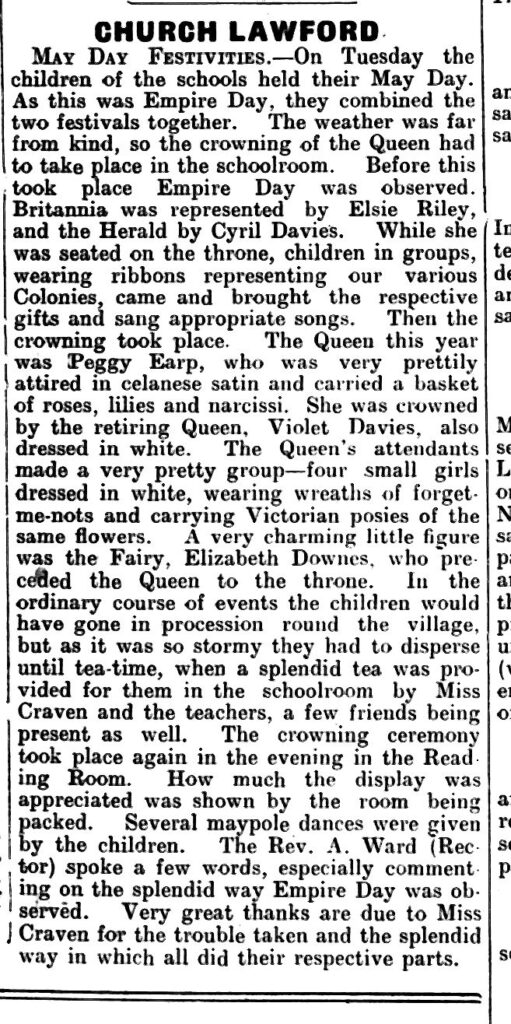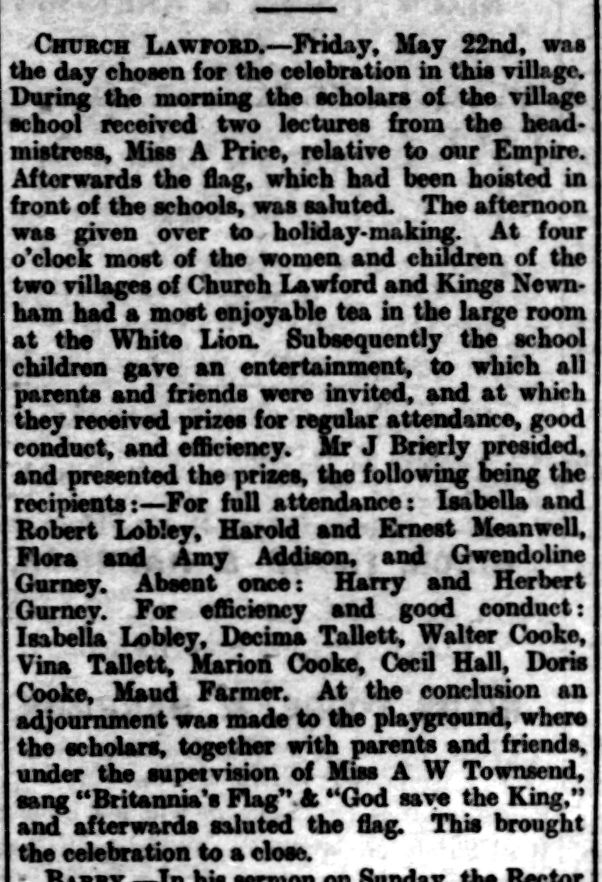The Traditional May Day Festival was celebrated in the two villages for many years. The May Day Festival and Parade is discussed here, and the May Queen celebrations are discussed here. A list of the Village May Queens has also been compiled. The village school also closed for the May Day festival up until the Second World War.
A Report from the Rugby Advertiser of 11th May 1912 highlights the complete May Day celebration, including the parade around the two villages.
Church Lawford and Kings Newnham are very conservative in regard to old institutions, and when last week a rumour gained ground there was to be no May Day every one, little and big, was stirred to an extent far greater than during the railway or coal strikes.
The senior scholars canvassed the parishes with such success that offers of help and contributions promised, ensured a record event. The School Managers secured Friday. May 3rd, as a whole holiday, and the use of a large barn, coach-house, and field for games was kindly given by the Chairman of the Parish Meeting.
A scarcity of flowers was feared, but the supply was so ample that the bath chair, which has been the Queen’s chariot for many years, was pronounced to look better than ever; and a fitting throne for the little May Queen, Doris Batchelor, who was becomingly attired in pure white, with a daisy wreath, and veil, and carried a lovely white bouquet-another gift. She was drawn by Doris Faulkner and Elsie Pincham. Her twin sister, Lucy Batchelor, and last year’s Queen, Marjorie Thompstone, also helped, with ropes of cowslips, and what are usually known as” May blobs.”
The attendant maids were: Evelyn and Doris Cooke, Maudie Farmer, Dolly Daniels, and Bessie Lobley. The other scholars, girls and infants, filed after them, the rear being brought up by а real old-fashioned May garland, carried in turn by M Hall, E Adderly, D Reeves, and M Raven.
Several “old girls” had taken a day off “to help,” and they and some mothers superintended the ramble round the two parishes and outlying houses, which lasted till 2.30 p.m. The collection was a record, viz, £3 17s 9d, and the Queen’s private purse held 14s 8d. At 4.30 p.m, all assembled at the barn for tea, and as the children had invited all the boys and many friends, there were over 100 present to enjoy the sumptuous spread. Very little had to be provided out of the fund, as friends had given bread, cakes, buns, butter, tea, milk, sugar, jam, fruit, and custards, and there was no doubt as to the excellence of the contributions.
After tea the children played and rode by turns on a “rocking-horse,” another kindly loan, while the waiters had tea. Next on the programme was the sports, ably carried out by the Messrs Cooke and Riley. The prizes consisted of 230 oranges and 22lbs of sweets. The last event was very mirth provoking, and the fun continued till about 8.0 p.m, when all adjourned to the Dutch barn, where the National Anthem was sung, and hearty cheers were given by the children for all who had helped to make the May Day so successful.
As they dispersed oranges and sweets were given to each one. The weather was all that could be wished for, the happiest May Day ever known at Church Lawford; and, as the tired helpers left the scene, the longed-for rain began to fall. The girls very generously voted the boys 3d each, and the surplus was shared by girls and infants. This amounted to 1s 8d each for the biggest girls and 1s for the little ones. Much credit is due to the mothers, who dressed all the children so prettily for the procession and the tea.
From early in the twentieth century the villages also took part in the Empire Day Celebrations, planned for 24th May. This was also a Spring Festival, and in some years it was celebrated on the same day as the May Day Festival, but on other days it was a separate rather more solemn celebration which allowed the school children to have a half-day holiday in the afternoon, following a morning of lessons where they were taught about the Empire.
The May period was also the time for other events without an exact annual date, which could be marked by school closure, such as Ascension Day (39 days after Easter Sunday) and the Whitsuntide Holiday (the week after Whit Sunday (Pentecost) – the seventh Sunday after Easter).
For example in 1932 the May Day and Empire Day celebrations were held at the same time, as discussed in the Rugby Advertiser of 27th May 1932.

Empire Day was first celebrated in 1902, the year after the death of Queen Victoria, with the ceremonies held on 24th May – the late Queen’s birthday. It did not become an official annual event until 1916, but the two villages did recognise it before that, as shown in the following article from the Rugby Advertiser of 30th May 1908.

After around 50 years the celebration was renamed as British Commonwealth Day in 1958 and then to Commonwealth Day in 1966, when the date also changed to the Monarch’s Official birthday – 10th June for Queen Elizabeth II.
